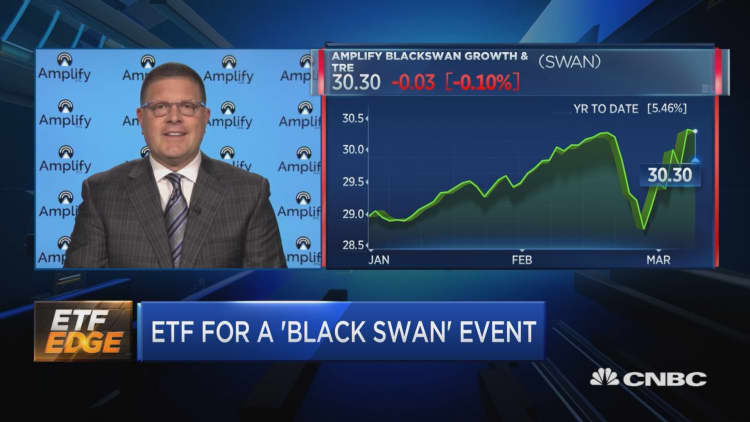
When it comes to black-swan events, a global pandemic certainly makes the cut.
With the spread of the coronavirus sending U.S. markets into a tailspin in recent weeks — occasionally punctuated by big upswings as stocks tried to recover from the steep declines — investors are likely seeking some stability.
Some have been flocking to exchange-traded funds that invest in stocks with lower volatility profiles such as the iShares Edge MSCI Min Vol USA ETF (USMV) or the Invesco S&P 500 Low Volatility ETF (SPLV).
But with those two funds still down sharply for the year — USMV has fallen 16% to a new 52-week low as of Friday, while SPLV has shed about 17% — CNBC's "ETF Edge" looked into another option that's been holding up much better.
Amplify's Black Swan Growth and Treasury Core ETF (SWAN) is only down about 1% year to date versus the S&P 500's 21% decline, which can be attributed in part to the fund's makeup, Amplify founder and CEO Christian Magoon told "ETF Edge" this week.
"The theory behind Black Swan is to own S&P exposure, but to also own U.S. Treasurys. During times of market crisis, Treasurys are bought up like crazy and they act as a great negative-correlated asset to equity exposure," Magoon said Monday.
The fund is roughly 65% Treasurys and 35% S&P exposure via LEAP options, or option contracts that expire in at least one year (LEAP stands for long-term equity anticipation), Magoon said, adding that it rebalances twice a year, but keeps its exposure "fairly constant."
"This works a lot like a traditional, balanced portfolio, but really shines during times of market crisis," he said. "This is a fund that does work [to] hedge against black-swan risks, but [is] also something you can hold in an upward-moving market. So, it's really a core holding."
Others, including Dave Nadig, chief investment officer and director of research at ETF Trends, said investors would be wise to do their research before buying into funds like these.
"The important thing is you really have to understand the mechanics of how these things are going to work," he said in the same "ETF Edge" interview. "You've really got to be careful."
That means understanding things like tail-risk funds, which leverage put options to hedge against higher market volatility and can have varying degrees of performance, Nadig said. As of Monday, he saw "a 30% dispersion" between the best- and worst-performing tail-risk ETFs so far in 2020.
SWAN gained nearly 3.5% in Friday's trading session.





